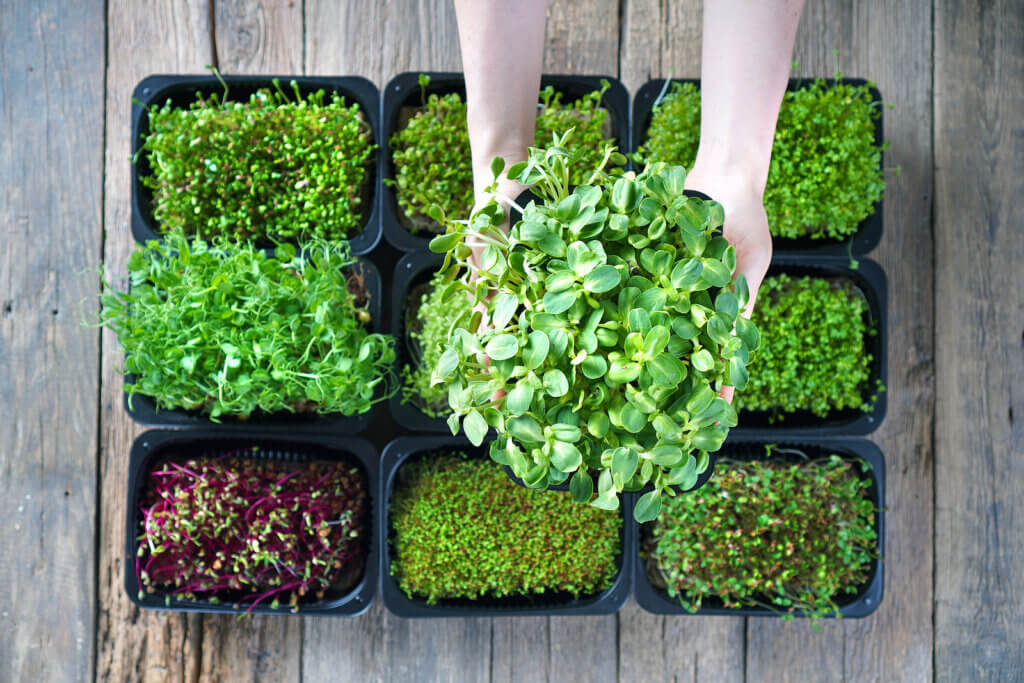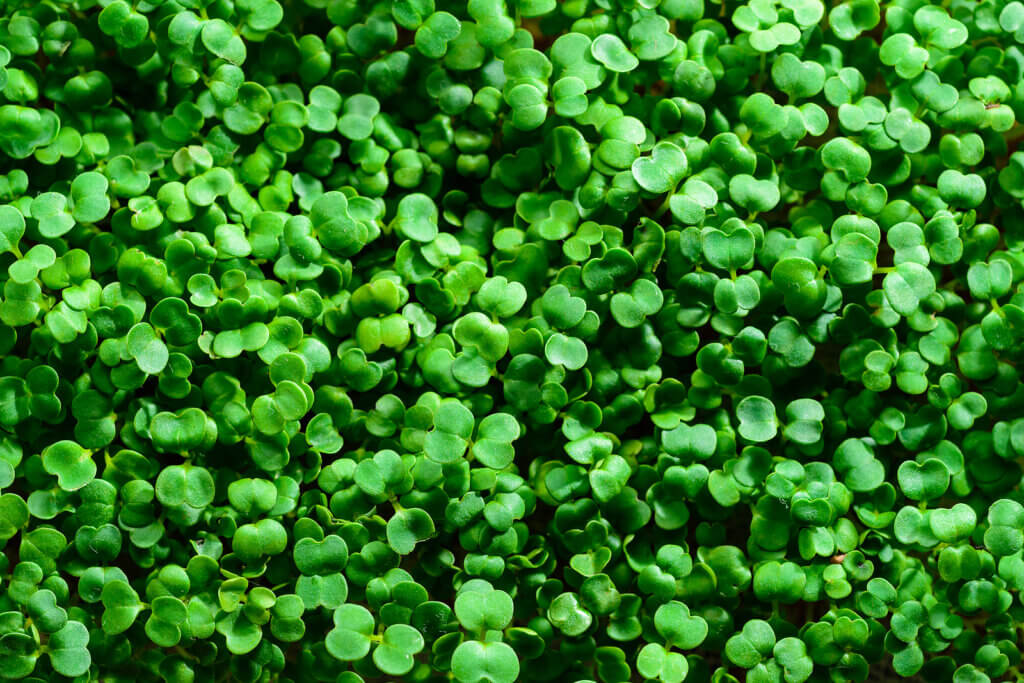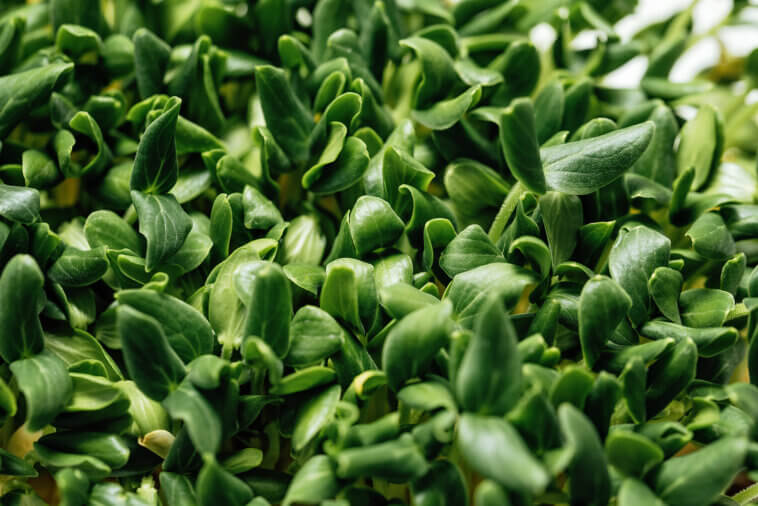Table of Contents
I've been fascinated by a culinary trend that's been making waves in the food world: microgreens. These little powerhouses have completely captured my culinary imagination, and I can't help but be excited about the burst of color and incredible nutrition they bring to a variety of dishes.
Join me on a journey into the captivating world of microgreens, where we'll explore their origins, cultivation, mind-blowing health benefits, and the countless creative ways you can elevate your cooking with them.
Whether you're a budding gardener like me, a seasoned food lover, or simply intrigued by these tiny greens, this article is your go-to resource for all things microgreens health benefits of microgreens.
The Fascinating World of Microgreens
Microgreens, often referred to as nature's miniature masterpieces, represent a captivating class of young, edible plants meticulously harvested during the initial stages of growth, specifically when they have sprouted their first set of true leaves, scientifically known as cotyledons.
These diminutive greens, typically measuring no more than 1 to 3 inches in height, are renowned not only for their compact size but also for their remarkable diversity in terms of colors, shapes, and flavor profiles.
This unique combination of traits renders microgreens an incredibly versatile and captivating ingredient, elevating their significance in the world of culinary arts. From vibrant hues to intense flavors, microgreens offer a cornucopia of possibilities for enhancing the visual appeal and taste of dishes, making them an indispensable component in the realm of gastronomy sprouting microgreens.
Read also our post on China Rose Radish Microgreens
Exploring the Growing Popularity of Microgreens
The burgeoning trend of microgreens has garnered remarkable attention in recent years, driven by a host of compelling factors that underscore their significance:
Nutrient Density
Microgreens have emerged as nutritional powerhouses, celebrated for their exceptional concentration of essential vitamins, minerals, and antioxidants, often surpassing their fully grown counterparts in these aspects. Incorporating microgreens into one's diet can provide a potent dose of essential nutrients.
Cultivation Accessibility
A key allure of microgreens lies in their accessibility for cultivation. Their adaptability to indoor growing conditions throughout the year makes them an accessible option for urban dwellers, those with limited gardening space, and even novice gardeners. This accessibility empowers individuals to take charge of their food production.
Swift Growth Cycle
Microgreens exhibit an astonishingly rapid growth cycle, typically reaching maturity in a mere 7 to 21 days from the moment the seeds are sown. This swift turnaround not only gratifies the impatient gardener but also reinforces microgreens' appeal as a practical and rewarding choice for home cultivation.
Sensory Pleasures
Microgreens tantalize the senses with their vibrant colors and robust flavors. These miniature greens have the remarkable ability to enhance the visual appeal and taste of a wide range of dishes, imparting both aesthetic allure and delectable flavor profiles to culinary creations.
Health Benefits
Beyond their flavor and appearance, microgreens offer substantial health benefits. Their rich nutritional content has been associated with improved digestion, reduced inflammation, and increased energy levels. These potential health advantages have further fueled the fascination with microgreens, prompting their inclusion in health-conscious diets and culinary ventures amaranth microgreens.

The Nutritional Treasure Trove within Microgreens
Microgreens, often dubbed as “nutrition powerhouses,” are replete with an impressive array of essential nutrients, making them a treasure trove of health benefits. Delve deeper into the wealth of nutrients that these miniature wonders offer:
Vitamins Galore
Microgreens are a rich source of vitamins, including vitamin C, known for its immune-boosting properties; vitamin K, crucial for blood clotting and bone health; vitamin E, a potent antioxidant; and a spectrum of B vitamins, which are vital for various bodily functions, including energy metabolism beet microgreens.
Mineral Abundance
Within microgreens, you'll find an abundance of essential minerals such as calcium, indispensable for strong bones and teeth; iron, essential for oxygen transport in the blood; magnesium, supporting muscle and nerve function; and potassium, which plays a key role in maintaining healthy blood pressure and electrolyte balance.
Antioxidant Arsenal
Microgreens are teeming with antioxidants, including carotenoids like beta-carotene and lutein, as well as polyphenols. These antioxidants act as cellular bodyguards, protecting your cells from oxidative stress and reducing the risk of chronic diseases like heart disease and cancer.
Phytonutrient Power
Microgreens are a rich source of phytonutrients, bioactive compounds found in plants. These compounds offer a range of health benefits, including anti-inflammatory and anti-cancer properties, contributing to overall well-being.
Fiber Fuel
Microgreens add a valuable dose of dietary fiber to your diet. This fiber aids in maintaining digestive health, regulating blood sugar levels, and supporting healthy weight management.
Protein Presence
While not as protein-rich as some other plant-based foods, microgreens still contribute a moderate amount of protein. This makes them a noteworthy addition, particularly for individuals following vegetarian or vegan diets, where plant-based protein sources are essential.
A Step-by-Step Guide to Growing Microgreens at Home
Growing microgreens at home is an immensely satisfying and rewarding endeavor. Here's an in-depth exploration of each step to help you embark on this green journey.
Equipment and Setup
- Containers: Your choice of containers is essential. You can use trays, shallow pots, or even repurpose various containers you have at hand. Ensure they have adequate drainage holes or add them to prevent waterlogging.
- Growing Medium: Select a sterile growing medium such as potting mix, coconut coir, or vermiculite. This medium should provide a healthy foundation for your microgreens' growth.
- Seeds: The quality of your seeds is crucial. Opt for high-quality seeds explicitly labeled for microgreen production. Popular choices include broccoli, radish, kale, and sunflower seeds.
- Light Source: Adequate light is paramount for successful microgreen growth. You can place your containers on a sunny windowsill or utilize artificial grow lights, ensuring they are on for 12 to 16 hours a day to mimic natural daylight.
- Watering Supplies: Equip yourself with a spray bottle or a watering can with a fine mist setting to maintain the necessary moisture level in the soil.
- Humidity Dome or Plastic Wrap: Create a mini-greenhouse effect by covering your containers with a humidity dome or plastic wrap to maintain a humid environment during germination.
Selecting the Perfect Seeds
Different microgreens offer a wide spectrum of flavors, growth rates, colors, and nutritional profiles. Here are some factors to consider when selecting your microgreen seeds:
- Taste Preferences: Opt for microgreen varieties that align with your taste preferences. For instance, arugula microgreens impart a peppery zing, while basil microgreens offer aromatic sweetness.
- Growth Rate: Microgreens exhibit varying growth rates. If you're impatient to see results, consider quicker-growing varieties like radish or mustard.
- Color Palette: The colorful array of microgreens can add an artistic touch to your dishes. Experiment with different hues for visual appeal.
- Nutritional Goals: Research the nutritional content of various microgreens to ensure you're obtaining specific health benefits tailored to your needs.
Planting and Nurturing Microgreens
- Container Preparation: Fill your chosen containers with the selected growing medium, leaving about an inch of space at the top to accommodate the developing microgreens.
- Sowing Seeds: Sprinkle the seeds evenly across the surface of the soil. You can sow them relatively densely, as microgreens won't grow to full size.
- Seed Pressing: Gently press the seeds into the soil using a flat object (such as a piece of cardboard or a small board) to ensure good seed-to-soil contact. This promotes germination.
- Watering: Mist the seeds with water to moisten the soil thoroughly. To prevent dislodging the seeds, use a gentle spray. Ensure the soil remains consistently moist but avoid overwatering, as excessive moisture can lead to mold or fungal issues.
Harvesting and Storage Tips
Microgreens are ready for harvest when they have developed their first true leaves, which typically occurs within 7 to 21 days after planting. Here's how to harvest and store them:
- Use Scissors or a Sharp Knife: To harvest microgreens, cut them just above the soil line using scissors or a sharp knife.
- Harvest in Batches: Harvest microgreens in small batches as needed to ensure freshness. This practice allows you to enjoy their peak flavor and nutritional value.
- Rinse Gently: After harvesting, gently rinse the microgreens with cool water to remove any soil particles. Allow them to drain thoroughly.
- Immediate Enjoyment: Microgreens are best enjoyed immediately after harvest. Incorporate them into your dishes for a burst of flavor and nutrition.
Unleashing Culinary Creativity with Microgreens
Microgreens are not just visually and nutritionally appealing; they are also incredibly versatile in the culinary realm. Here's an extensive exploration of the various creative ways you can incorporate microgreens into your culinary repertoire.
Enhancing Flavor and Nutrition
- Salads: Elevate your salads to new heights by sprinkling a handful of microgreens on top. They provide texture, flavor, and an impressive nutritional boost.
- Sandwiches and Wraps: Microgreens make exceptional additions to sandwiches and wraps, contributing an extra layer of crunch, freshness, and nutrition.
- Garnish Galore: Enhance the presentation and flavor of soups, omelets, pasta dishes, and more by using microgreens as an elegant garnish.
- Smoothie Supercharge: Boost the nutritional content of your morning smoothie by blending in a handful of microgreens. This stealthy addition adds nutrients without altering the taste significantly.
- Stir-Fry Surprise: When preparing stir-fries, toss in a handful of microgreens during the last minute of cooking to introduce vibrant colors and a burst of freshness.
Spotlight on Popular Microgreen Varieties and Their Culinary Applications
- Basil: Basil microgreens offer a sweet, aromatic touch that is perfect for enhancing the flavor of pizzas, pastas, and caprese salads.
- Radish: Known for their peppery kick, radish microgreens pair wonderfully with spicy dishes and find a special place in Asian cuisine.
- Arugula: Imparting a spicy, nutty flavor, arugula microgreens are ideal for salads, sandwiches, and as a zesty pizza topping.
- Sunflower: Sunflower microgreens offer a mild, nutty taste, making them versatile and suitable for a wide range of dishes.
- Kale: With its hearty, earthy flavor, kale microgreens make a great addition to smoothies, salads, and even as a topping for sandwiches.

Obtaining Microgreens: Options and Considerations
While growing microgreens at home is a rewarding experience, you may prefer to purchase them for convenience or due to space limitations. Here are some options and considerations when obtaining microgreens.
Support Local Farmers' Markets
Many local farmers' markets offer freshly harvested microgreens grown by dedicated local producers. This is an excellent way to support small-scale farmers and ensure the freshness of your microgreens.
Exploring Grocery Store and Online Purchases
Alternatively, you can explore grocery stores, supermarkets, and online retailers for packaged microgreens. Many grocery stores now carry pre-packaged microgreens in the produce section. Online retailers offer a wide variety of microgreen seeds and pre-grown microgreens for purchase, providing a convenient option for those who may not have access to local farmers' markets.
The Future of Microgreens: What Lies Ahead
The horizon for microgreens brims with promise and potential, propelled by their ever-increasing popularity. Here, we explore the unfolding trends and developments that foreshadow an exciting future for these miniature marvels:
Innovative Varieties Blossom
Breeders and cultivators are at the forefront of a botanical revolution, continually crafting novel microgreen varieties. These newcomers exhibit an array of distinctive flavors, colors, and textures, enriching the landscape of culinary experimentation. As this innovation continues, the possibilities for gastronomic creativity are boundless.
Wider Availability Beckons
The surging demand for microgreens is likely to reshape their accessibility. Expect to see these tiny greens gracing the shelves of grocery stores and the menus of restaurants with increasing frequency. This broader availability promises to introduce microgreens to a more diverse and expansive audience, transcending the boundaries of gourmet cuisine.
Expanding Scientific Exploration
The scientific community's fascination with microgreens shows no signs of waning. Research endeavors dedicated to unraveling the full spectrum of health benefits inherent in microgreens are anticipated to surge. These investigations may unearth even more compelling reasons to incorporate these nutrient-rich greens into our daily diets, potentially revolutionizing our approach to nutrition.
Sustainable Cultivation Practices
As the world grapples with environmental challenges, the cultivation of microgreens may evolve towards more sustainable practices. Innovations in growing techniques, such as hydroponics and vertical farming, may further reduce the ecological footprint of microgreen production, aligning them with the principles of eco-conscious dining.
Mainstream Culinary Integration
Microgreens are poised to transcend their current status as a culinary trend. They are likely to integrate seamlessly into the mainstream culinary world, becoming a standard ingredient in both home kitchens and professional cookeries. The unique combination of aesthetics and flavors they offer ensures their place at the center stage of modern cuisine.
Frequently Asked Questions (FAQs)
Q1: Are microgreens the same as sprouts?
A1: No, microgreens and sprouts are not the same. While both are young plants, microgreens are typically grown in soil and harvested after the development of their first true leaves. In contrast, sprouts are germinated seeds or legumes that are grown in water and harvested before they develop leaves. Microgreens offer a wider range of flavors, textures, and nutrients compared to sprouts.
Q2: Can I grow microgreens without natural sunlight?
A2: Yes, you can grow microgreens without natural sunlight. While natural sunlight is ideal, you can also use artificial grow lights, such as fluorescent or LED lights, to provide the necessary light for microgreens. Position the lights so they are 2-4 inches above the microgreens and keep them on for 12-16 hours a day to mimic the daylight cycle.
Q3: How long do microgreens stay fresh after harvesting?
A3: Microgreens are at their freshest immediately after harvesting. To maximize their freshness, store them in an airtight container or a plastic bag in the refrigerator. Depending on the variety and storage conditions, microgreens can stay fresh for 5-10 days. It's best to consume them as soon as possible for the best flavor and nutrition.
Q4: Can I freeze microgreens for later use?
A4: While it's possible to freeze microgreens, it's not recommended because freezing can affect their texture and flavor. Microgreens are best enjoyed fresh for their vibrant colors and flavors. If you have an abundance of microgreens, consider sharing them with friends, family, or neighbors, or use them generously in your meals.
Q5: Are there any common pests or diseases that affect microgreens?
A5: Yes, microgreens can be susceptible to pests and diseases such as aphids, fungal infections, and damping-off disease. To prevent these issues, maintain good hygiene in your growing area, ensure proper air circulation, and avoid overwatering. If pests or diseases do appear, consider using natural remedies like neem oil for pests or adjusting watering practices to combat diseases.
Q6: Can I reuse the soil or growing medium for multiple batches of microgreens?
A6: It is not advisable to reuse the soil or growing medium for multiple batches of microgreens. Over time, the growing medium can become depleted of nutrients, increasing the risk of disease and decreasing the growth quality of your microgreens. It's best to start each batch with fresh, sterile growing medium to ensure healthy and vigorous growth.
Conclusion
In wrapping up this journey through the vibrant world of microgreens, I find myself truly inspired by the potential these tiny greens offer in my culinary endeavors and daily life.
Their remarkable diversity in taste, color, and health benefits has not only ignited my passion for cooking but also deepened my commitment to a healthier and more sustainable lifestyle. Whether I choose to grow them at home or source them from local markets, microgreens have become an indispensable part of my culinary repertoire.
As I look ahead, I'm excited about the ever-expanding possibilities that await in the world of microgreens. Their growing popularity and continuous innovations promise to bring new flavors and experiences to my kitchen. Microgreens have not only elevated the aesthetics and flavors of my dishes but have also broadened my perspective on food and nutrition.
So, as I continue to explore the world of these miniature marvels, I'm eager to embrace the creativity they inspire and the vibrant, healthy dishes they contribute to my table. Cheers to the captivating universe of microgreens and the delicious adventures yet to come!
Sources
https://research.reading.ac.uk/research-blog/microgreens-the-health-giving-shoots-explained/




Comments
Loading…